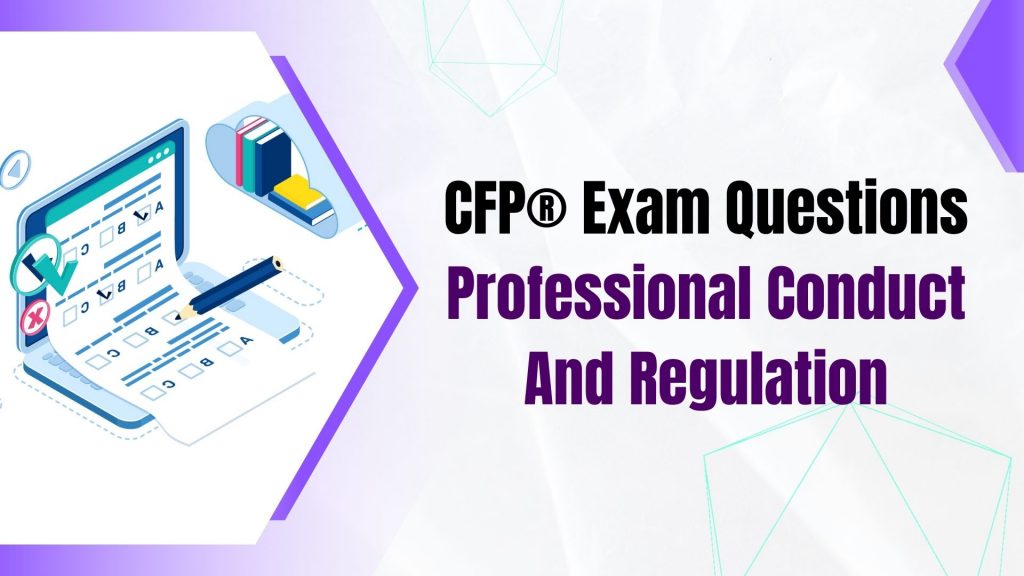Free CFP® exam sample questions – Professional conduct and regulation

Time constraints often prove to be a stumbling block for numerous aspiring CERTIFIED FINANCIAL PLANNER™ exam candidates, hindering their ability to score high or effectively solve the questions. The CFP® exam comprises a total of 170 multiple-choice questions and must be completed within a time limit of 6 hours, divided into two 3-hour sections. To suitably attempt all the questions within the stipulated time, the aspirants need to efficiently allocate a specific duration for each section.
One of the best ways to become better at managing time is by attempting many multiple-choice questions (MCQs). Giving priority to the practice questions will aid aspirants in getting into the habit of allocating sufficient minutes to each question, accurately analyzing complex scenarios, and providing well-thought-out responses. In this blog, CFP® Exam Prep by Achieve provides ten free sample exam questions from professional conduct and regulation to help you get well-versed in the subject. Solve these and more such practice questions to identify the types of questions that consume more time and those that can be swiftly answered.
Q 1. A CFP® Board designee is breaking which principle of the CFP® Code of Ethics by recruiting customers through false advertisements?
A. Integrity
B. Competence
C. Professionalism
D. Sound and Objective Professional Judgment
Click here for answer and detailed explanation
Q 2. The CFP Board may issue a public letter of admonition in which of the following situations?
A. If a CFP fails to graduate from college
B. If one CFP accuses another of unlawful action
C. If a CFP Board designee has requested it
D. If grounds for discipline have been established against a CFP Board designee
Click here for answer and detailed explanation
Q 3. Within how many days must material changes and updates to public disciplinary history or bankruptcy information be communicated to the Client?
A. 30
B. 45
C. 60
D. 90
Click here for answer and detailed explanation
Q 4. What federal agencies are in charge of overseeing qualified retirement plan regulations and eligibility?
A. The IRS and the Department of Labor
B. The U.S. Treasury and the IRS
C. The Department of Labor and Congress
D. The U.S. Securities and Exchange Commission and the U.S. Treasury
Click here for answer and detailed explanation
Q 5. Which of the following is primarily governed by state legislation?
A. Insurance companies
B. Broker-dealers
C. Medicare
D. IRAs
Click here for answer and detailed explanation
Q 6. Which of the following best describes a CFP® professional’s obligations when identifying and selecting goals for a financial planning client?
A. A CFP® professional must identify potential goals and then select the goals for the client
B. A CFP® professional must help the client identify goals and then help the client select and prioritize goals
C. A CFP® professional must request that the client select the goals that the client wishes to accomplish
D. A CFP® professional must work with the client to mutually select the client’s goals
Click here for answer and detailed explanation
Q 7. A CFP® Certificant is an investment advisor with federal registration who oversees $250 million in client assets. He just had a meeting with a potential client who was eager to work with the CFP Certificant. The client wants to put in $50000. When must the CFP Certificant provide the prospect with Part 2 of his Form ADV?
A. 48 hours after the client signs the engagement letter
B. When a client authorizes a account application
C. Within 24 hours of the client making a financial contribution to their brokerage account
D. Within 48 hours following the delivery of the plan
Click here for answer and detailed explanation
Q 8. A well-known basketball player who competes in the National Basketball Association is a client of a CFP® Certificant (NBA). After a meeting with a client, the CFP® Certificant suggests taking a photo with them, and the client accepts. Without the client’s awareness, the CFP® Certificant shares the photo on social media with the hashtag #newNBAclient. Has the CFP Board’s Code of Ethics been breached by the CFP® Certificant?
A. No, because the client posed for the picture
B. Yes, the CFP® Certificant violated the principle of objectivity
C. Yes, the CFP® Certificant violated the fiduciary duty
D. Yes, the CFP® Certificant violated the duty of confidentiality and privacy
Click here for answer and detailed explanation
Q 9. The code of ethics has been broken by a CFP® Certificant. She has decided not to contest the CFP Board’s conclusions after her actions were brought to their attention. Which of the following are methods of discipline available to the CFP Board?
A. Private censure
B. Private letter of admonition
C. 10-year suspension of certification
D. Temporary revocation of certification
Click here for answer and detailed explanation
Q 10. Grayson, an investment adviser representative who is registered with the SEC, thinks he has discovered a “cannot miss” investment approach. He wants to start marketing the success of his portfolio, which he claims has outperformed the market nine out of the past ten years. Which of the following must he additionally mention when he runs his advertisement?
A. The effect of material market or economic conditions on the results advertised
B. Whether or when and how much the claimed results incorporate dividends or other profits
C. Disclosing that there is a potential for loss
D. All of the above
Click here for answer and detailed explanation
Make it a habit to monitor the time taken to answer each question. This knowledge will empower you to develop an effective preparation strategy, ensuring that you can successfully tackle all the questions within the allotted time during your CFP® exam. Even on your busiest days, make it a routine to solve MCQs from the CFP® Exam Prep by Achieve App as that is the key to a successful financial career.